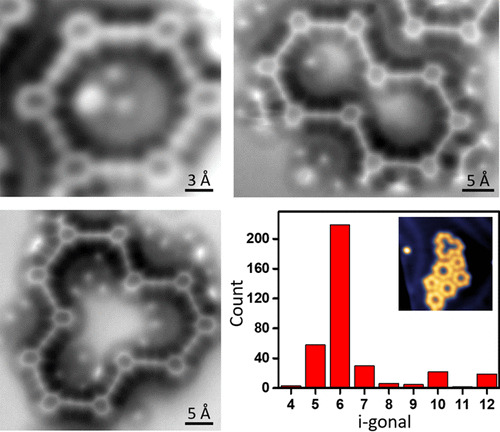Our official English website, www.x-mol.net, welcomes your
feedback! (Note: you will need to create a separate account there.)
High-Yield Formation of Graphdiyne Macrocycles through On-Surface Assembling and Coupling Reaction
ACS Nano ( IF 15.8 ) Pub Date : 2018-12-04 00:00:00 , DOI: 10.1021/acsnano.8b07349 Mengxi Liu 1 , Shichao Li 1, 2 , Jingyuan Zhou 3, 4 , Zeqi Zha 1, 2 , Jinliang Pan 1, 2 , Xin Li 1, 2 , Jin Zhang 3 , Zhongfan Liu 3 , Yuanchang Li 5 , Xiaohui Qiu 1, 2
ACS Nano ( IF 15.8 ) Pub Date : 2018-12-04 00:00:00 , DOI: 10.1021/acsnano.8b07349 Mengxi Liu 1 , Shichao Li 1, 2 , Jingyuan Zhou 3, 4 , Zeqi Zha 1, 2 , Jinliang Pan 1, 2 , Xin Li 1, 2 , Jin Zhang 3 , Zhongfan Liu 3 , Yuanchang Li 5 , Xiaohui Qiu 1, 2
Affiliation

|
Rationally designed halogenated hydrocarbons are widely used building blocks to fabricate covalent-bonded carbon nanostructures on surfaces through a reaction pathway involving generation and dissociation of organometallic intermediates and irreversible covalent bond formation. Here, we provide a comprehensive picture of the on-surface-assisted homocoupling reaction of 1,3-bis(2-bromoethynyl)benzene on Au(111), aiming for the synthesis of graphdiyne nanostructures. Submolecular resolution scanning tunneling microscopy and noncontact atomic force microscopy observations identify the organometallic intermediates and their self-assemblies formed in the dehalogenation process. The demetallization of the organometallic intermediates at increased temperatures produces butadiyne moieties that spontaneously formed two different covalent structures (i.e., graphdiyne zigzag chains and macrocycles), whose ratio was found to depend on the initial coverage of organometallic intermediates. At the optimal condition, the stepwise demetallization and cyclization led to a high-yield production of graphdiyne macrocycles up to 95%. Statistical analysis and theoretical calculations suggested that the favored formation of macrocycles resulted from the complex interplay between thermodynamic and kinetic processes involving the organometallic bonded intermediates and the covalently bonded butadiyne moieties.
中文翻译:

通过表面组装和偶联反应高产形成石墨二炔大环
合理设计的卤代烃广泛用于通过反应途径在表面上制造共价键合的碳纳米结构的反应单元,该反应途径涉及有机金属中间体的生成和解离以及不可逆的共价键形成。在这里,我们提供了一个表面辅助的1,3-双(2-溴乙炔基)苯在Au(111)上的均相偶联反应的图片,旨在合成石墨二炔纳米结构。亚分子分辨率扫描隧道显微镜和非接触原子力显微镜观察确定了脱卤过程中形成的有机金属中间体及其自组装体。有机金属中间体在升高的温度下脱金属会生成丁二炔部分,该部分自发形成两个不同的共价结构(即,石墨二炔之字形链和大环),其比例取决于有机金属中间体的初始覆盖率。在最佳条件下,逐步的脱金属和环化作用可导致高达95%的石墨二炔大环化合物高产。统计分析和理论计算表明,大环的有利形成是由于热力学和动力学过程之间复杂的相互作用,其中涉及有机金属键合的中间体和共价键合的丁二炔部分。
更新日期:2018-12-04
中文翻译:

通过表面组装和偶联反应高产形成石墨二炔大环
合理设计的卤代烃广泛用于通过反应途径在表面上制造共价键合的碳纳米结构的反应单元,该反应途径涉及有机金属中间体的生成和解离以及不可逆的共价键形成。在这里,我们提供了一个表面辅助的1,3-双(2-溴乙炔基)苯在Au(111)上的均相偶联反应的图片,旨在合成石墨二炔纳米结构。亚分子分辨率扫描隧道显微镜和非接触原子力显微镜观察确定了脱卤过程中形成的有机金属中间体及其自组装体。有机金属中间体在升高的温度下脱金属会生成丁二炔部分,该部分自发形成两个不同的共价结构(即,石墨二炔之字形链和大环),其比例取决于有机金属中间体的初始覆盖率。在最佳条件下,逐步的脱金属和环化作用可导致高达95%的石墨二炔大环化合物高产。统计分析和理论计算表明,大环的有利形成是由于热力学和动力学过程之间复杂的相互作用,其中涉及有机金属键合的中间体和共价键合的丁二炔部分。











































 京公网安备 11010802027423号
京公网安备 11010802027423号